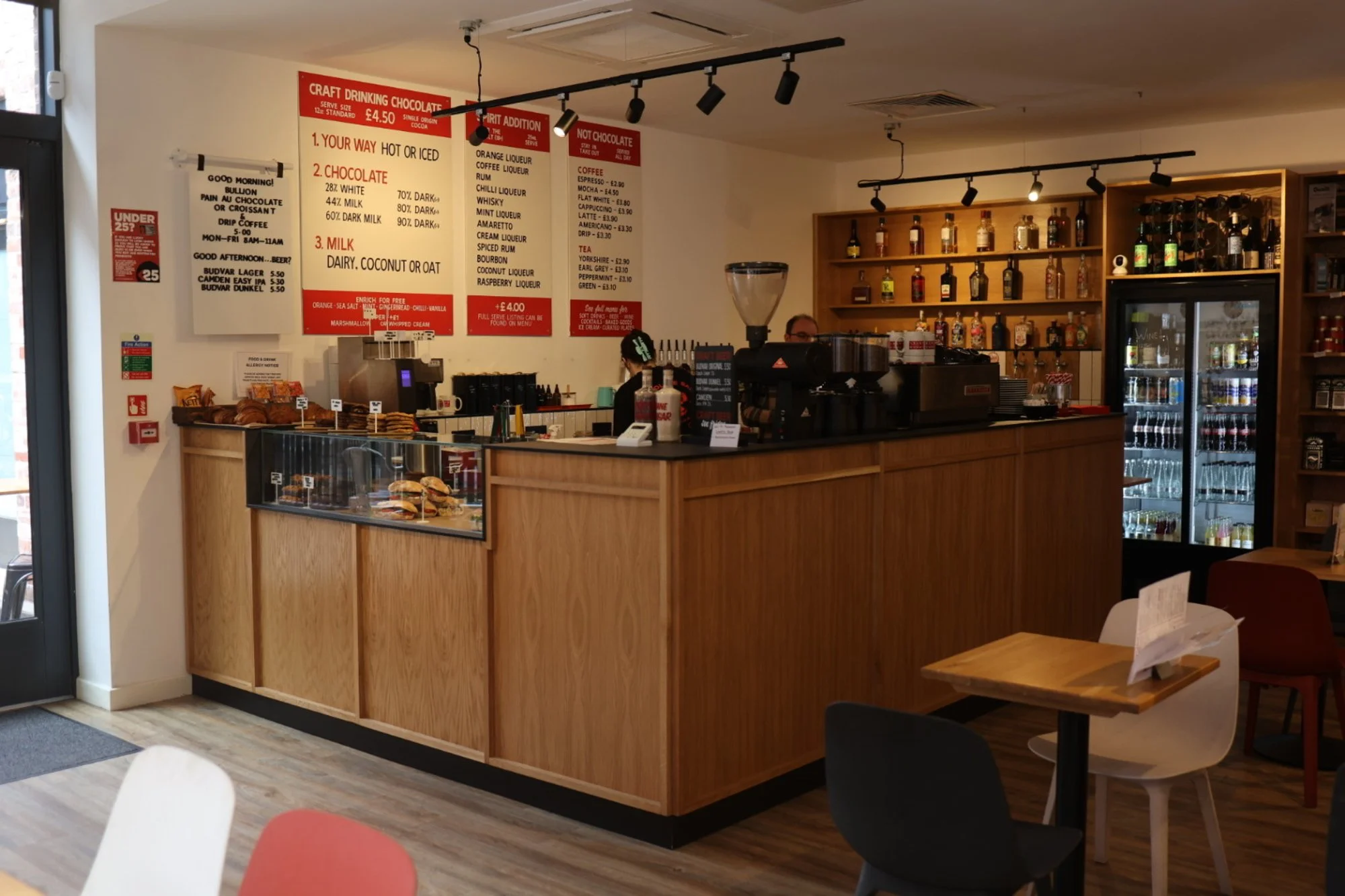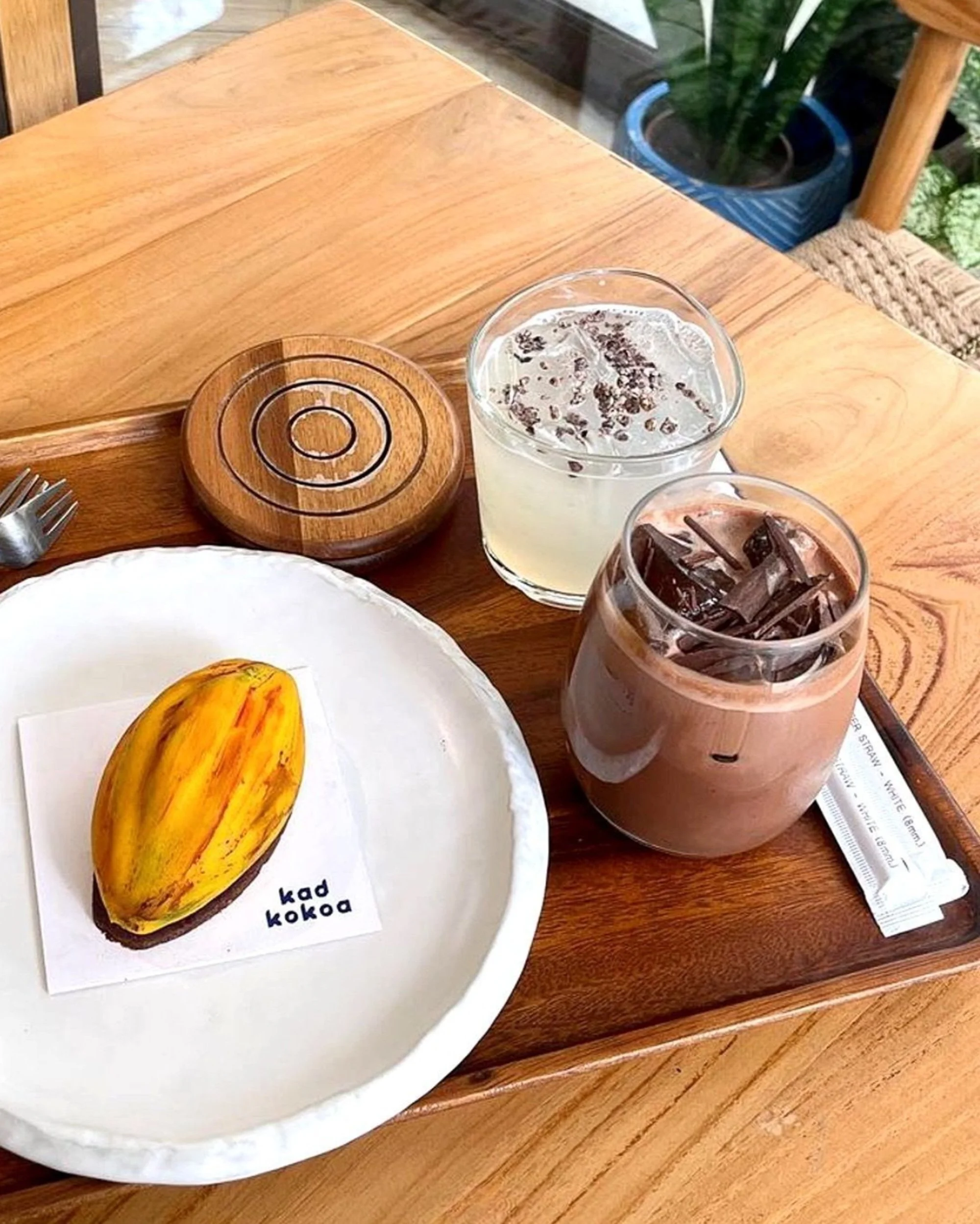The Return of the Chocolate House
Mörk chocolate photo credit Emily Weaving
In most cafés around the world, chocolate lovers have long been forced to watch their coffee and tea-loving friends drink exceptional brews, while they sipped on bland or ultra-sweet mixtures of cocoa powder and sugar. But now, the rise of craft chocolate is giving hot chocolate fans reason to be cheerful.
Hot history
Chocolate House in England (Anonymous, 1690-1700) ©British Museum
Chocolate has been consumed in liquid form for over 3500 years. Mesoamerican civilizations like the Olmecs and Mayans cultivated and consumed cacao as a frothy and often spiced beverage. That practice was taken to Europe by Spanish colonists in the early 1500s, and the Europeans soon added sugar, cinnamon and vanilla to make it more appealing to local palates.
Chocolate’s arrival in Europe was closely followed by coffee from Ethiopia and tea from China. For a while, drinking chocolate was extremely popular with European royalty, noblemen, and politicians. In the 17th and 18th centuries, specialty chocolate houses were very popular amongst the wealthy and the elite, particularly in England and France. Important members of society would meet there to discuss current events.
However, by the end of the 18th century, coffee and tea had become much more popular than hot chocolate. This was due to a combination of factors, including cost, global availability, and the perceived energy-boosting properties of coffee and tea. Hot chocolate was a rare luxury for most, whereas coffee and tea became everyday drinks that were accessible for all.
While long ago eclipsed by other hot drinks, chocolaterias are still popular in Spain, where cups of thickened hot chocolate are served with churros and Paris is still lauded for its cafes serving exceptional hot chocolate. Read our Experts’ Top five Hot Chocolate Spots in Paris.
Culture shift
Mörk cafe photo credit Kristoffer Paulsen
Chocolate became cheaper and more available in the mid 19th century, but by that point tea and coffee dominated the hot drink market in most parts of the world. Because of this, hot chocolate has long been overlooked by cafés, seeming like an afterthought on the drinks list. “It’s often considered for children,” says Josefin Zernell, co-founder of Mörk Chocolate in Melbourne. “Children don’t matter in cafes – they’re secondary to grown-ups who have wallets.”
Josefin trained as a chocolatier in Stockholm before emigrating to Australia with her husband and business partner, Kiril Shaginov. In 2012, they launched Mörk’s first specialty drinking chocolate blend and set about elevating local chocolate culture to the level of Melbourne’s world-renowned coffee scene. “We wanted to make sure that people were respecting it,” says Josefin. “There was so much time spent on weighing, dosing and tamping the coffee in bars. With chocolate, there was just a scoop of something they got from their coffee supplier into a jug, some steamed milk on top; in a latte glass, and out it goes.”
Mörk now has five cafes in Melbourne, each offering a unique and intriguing list of hot and cold chocolate drinks, alongside chocolate-based baked goods, chocolate gifts and brewing equipment. The most popular drink on the menu is the Campfire Hot Chocolate – an interactive and multi-sensory drink that uses maplewood smoke, torched house-made marshmallow, charcoal salt, and Mörk’s signature 70% cacao drinking chocolate.
Bean to cup
Mörk founders Kiril Shaginov and Josefin Zernell photo credit Kristoffer Paulsen
Standard hot chocolate is made with alkalised cocoa powder and lots of sugar (often between 50% and 70%!) The cocoa powder is usually extracted from beans deemed too low quality to turn into chocolate, and the alkalization process removes acidity and heavily reduces the flavor. Conversely, specialty drinking chocolate contains real chocolate made from high quality cacao and is usually much less sweet. Unsurprisingly, the taste is more rich, nuanced and downright delicious than your average hot chocolate.
All of Mörk’s chocolate is now made from their bean-to-bar factory in North Melbourne, which opened in 2022. Their cacao is predominantly sourced from Ingemann Fine Cocoa in Nicaragua. Shares Josefin, “Our first bean-to-bar batch came out so beautiful… that was the most exciting moment. All of a sudden our drinking chocolate wasn’t just tasting better – it was so much more special because we had finally made it ourselves.”
Raising the bar
Chocolate Bar cafe
On the other side of the world, Max Scotford of Bullion Chocolate in Sheffield, UK, is also transforming drinking chocolate culture. His new project, Chocolate Bar, is an all-day craft chocolate café that serves single-origin hot or iced chocolates, a variety of other chocolate delicacies, and chocolate-based cocktails at night. It’s a business concept Max has dreamed of since he was 16 years old.
“It’s more than just a cafe – it’s an experience,” says Max. “When you go to a pub or somewhere like that, there’s a stigma of “well I’ve got to have a beer”. Whereas, when you come to Chocolate Bar; yes we do cocktails, craft beer and nice wines… but you can still have a really good hot chocolate and not feel out of place.”
Chocolate Bar’s drinking chocolate is made from Ghanaian beans sourced via Thee Mountains Cocoa. The most popular drink is the 70% dark, and its classic nutty and brownie notes make it accessible to craft chocolate newbies as well as easy to pair with a variety of spirits and liqueurs.
In the first five months of operation, Chocolate Bar sold over 30,000 hot chocolates, introducing a huge new audience to locally-made chocolate that’s both single-origin and transparently-sourced. “People come out of there knowing the story of craft chocolate,” says Max. “I’m not doing it for educational purposes, but I just want people to appreciate what they’re drinking.”
A Taste of Thailand
Over the past 10-15 years, craft chocolate has truly become a global movement. Wherever you go in the world, if you find small-batch bean-to-bar chocolate makers, you’ll probably find exceptional drinking chocolate as well. That is very much the case in Thailand, where craft chocolate has blossomed in the last decade.
Kad Kokoa drinks and confection
Founded in 2017, Kad Kokoa in Bangkok was one of the first Thai craft chocolate makers, and the company has played an integral part in putting Thai cacao on the chocolate map. “Twenty years ago, Thai people all thought that nothing produced here is good, and only imported products are high quality,” says Leo Sebag, Kad Kokoa’s CFO. “More and more, they understand that it’s actually the opposite.”
Craft chocolate is becoming popular in Thailand, but chocolate bars are not the most popular format. Locals prefer to consume chocolate drinks, pastries, bonbons and other treats. Kad Kokoa has two impeccably designed cafés and retail outlets, where you’ll find an inventive and enticing selection of iced chocolate drinks, colourful cacao-based morsels and beautifully packaged products on the shelves.
Leo believes that locals are more receptive to specialty drinking chocolate because of the huge popularity of bubble tea, matcha-based drinks and coffee. “With all these things, people consume around three or four per head, per day. Iced chocolate is part of this market.”
Gateway mugs
Hot chocolate mug photo credit Shashi Chaturvedula
Specialty drinking chocolate is a perfect introduction to fine-flavor cacao, and the incredible breadth and depth of flavors that craft chocolate offers. The price of a cup is usually less than a bar of craft chocolate, and it’s an experience that almost anyone can enjoy, even if they’re unaware of concepts like bean-to-bar or single origin.
With growing consumer demand for better drinking chocolate, cafés will soon realize that serving an ultra-sweet blend of cocoa powder and sugar isn’t good enough. Josefin Zernell believes the key to change is getting baristas hooked on the good stuff… “As soon as we started telling baristas and showing them what chocolate could be, all of a sudden they got really interested in what they were serving. They were more willing to talk about the chocolate with their customers. Baristas started talking to their barista friends or moving venues and taking the product with them… that’s how our brand spread very organically.”
Alongside the emergence of specialty chocolate cafés worldwide, we’re seeing a shift in how chocolate is enjoyed, from an often-private indulgence to a more social experience. Coffee and alcohol have been consumed communally for centuries, and now chocolate is again becoming something to share in public. In a way, the European chocolate houses of 17th-century nobility are making a comeback – only this time, everyone’s invited to the party.







